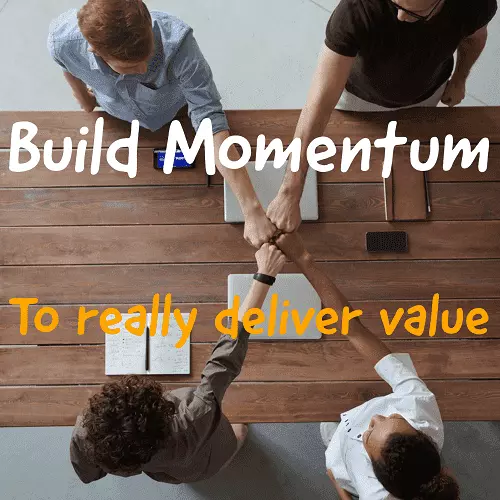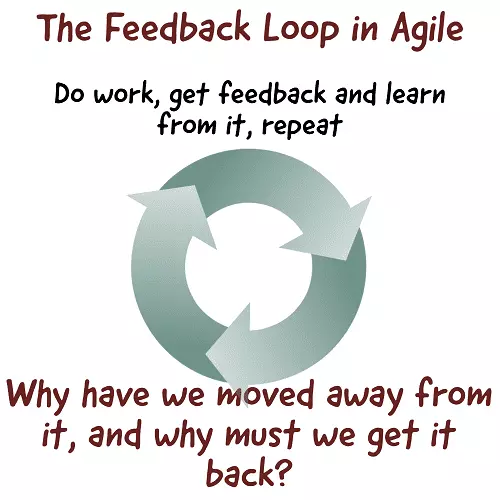
Agile team momentum is an often-overlooked factor in productivity during Agile development of software. Agile team momentum is the groove teams can get in that enables more efficient deliverables. This momentum is critical to delivering more value! It is a huge part of Agile processes and business value.
Build this momentum, and you will deliver more value to your organization. But, why is that?
These teams have found ways to navigate the work that enables success. They have an Agile flow that enables them to succeed. Let’s explore some of those items they navigate. Momentum is when you are firing on all cylinders and things are just easier. Enabling more Agile delivery of software products.
Let’s continue and find out more on Agile team momentum! Here is a table of contents to help find what you need.
Impediments to Agile Team Momentum
Fear of failure
This is when team members are worried about the repercussions of not succeeding. Either in providing the wrong solution or, a solution that is not good enough. Or, even still, a solution that has issues with it. Team members are too concerned with what happens if they do not succeed. This stops them from innovating. This stops them from collaborating for the best solution. To deliver quality software, there needs to be room to innovate and learn.
Fast-moving progress requires fast-moving learning and learning comes from sometimes having things wrong. Agile software development is all about learning and improving, to ultimately meet goals. So allow teams that room for things to be wrong, so that they can learn and move forward. Emphasize the ability to learn without being punished, so the team feels the freedom to do their best work.
Teams that work under constant fear of being punished when things don’t succeed cannot create good Agile flow.
Bureaucracy and culture
Sometimes organizations have extra stop gaps in their process. These pause the work before it can continue. Sometimes these are necessary, but often they are not. Often they are carry-over from more traditional SDLC, into Agile. From processes like the Waterfall model of developing software. Or, traditional project management practices with very formalized steps in the process. It’s possible that these are extra pieces of bureaucracy, which can be removed. Or, they may be part of a culture that needs more trust. Trust to complete work without extra reviews and extra approval processes.
Adopting more team collaboration and a less formalized process will improve solutions and decrease the time it takes to do work. It’s ok to think about Waterfall development for this one! That process had its pro’s and con’s, but if trying Agile, there are certain items from Waterfall that can be improved upon. To get there, individuals have to let go of past practices and let the Agile team be accountable for their work.
Evolving the bureaucracy and culture takes time, but it is well worth it. An Agile environment is more about teamwork and collaboration than well-defined tasks and job roles. Good Agile flow is not full of rigid process and hurdles in the process. Removing and mitigating these will let the team focus on the task at hand. Which ultimately leads to Agile delivery of software.
Goals of the work are unknown
When goals are unknown to the team, they will not be able to work consistently to move forward. Improve collaboration between the team members and end-users or stakeholders, to help understand the goals. Allowing the team member or members to work with users, will let them build a shared understanding of the software to be delivered. So don’t forget to share the common goal or goals with the team.
Simplicity in the work also enables a faster understanding of the work and goals. Starting with small pieces, continually adding until the full value needed is delivered. That is incremental progress in a nutshell and a core aspect is how simple or complex the work is. Break it down to enable its completion.
Having clear and concise goals for team members to understand and work towards also helps build Agile momentum. If team members don’t understand the direction of the work or if they don’t see the benefit in the work, and Agile team momentum is harder to come by. The project team will always take to the work better when they understand the goals of the work.
To promote Agile Momentum
Foster collaboration and communication
Team members working together share information. With this collaboration and teamwork, they share skill sets. Team members learn and build from each other, to put forth better work together. This promotes better knowledge sharing. It helps keep information out of silos. Promote collaboration whenever possible to help build cross-functional teams. Ensure team members know they can and should reach out to communicate with whomever they need to.
A good process shouldn’t bottleneck that communication through a project manager, scrummaster, or product owner. Project teams should have direct communication access to stakeholders and users to deliver real quality and value. Better communication helps build Agile momentum.
Good Agile flow has the people doing the work communicating directly with those that they need to. Getting information first hand. This is a big shift for a lot of organizations. As they feel there is efficiency in having someone else get the information and let the team keep working. But in reality, the team will be able to get the information faster and more accurately. Enabling them to build better solutions and successful Agile delivery.
Promote team solution building
Use brainstorming sessions or whiteboarding activities. Whatever tools that will get the team together to work collectively. Teams that collaborate on a solution will understand the solution better. This enables team members to do their portion of the work more effectively. Helping to build momentum, which leads to more value.
The best Agile requirements are those built and refined by the entire team. More expertise and knowledge goes into the requirements and more shared understanding for the team comes out of them. This improves the quality of work that comes from your sprint or iteration. It also improves the speed at which the team can deliver that work.
While working the product backlog, leverage team knowledge to create the best solutions possible. Good Agile flow involves the entire team and when the whole team works together, they create powerful solutions.
Celebrate success
The team needs to see value in their achievements. Take the time to celebrate what you accomplished. Often it doesn’t take much for the team to feel appreciation for the work. Team leaders need to help promote and share that sense of accomplishment from completing valuable work. As well as share information on what that work gains for the company. Use the specific product measure or metric that shows success when possible.
Agile values do not remove the idea of celebrating success. If anything, they include ideas to help build good team work and collaboration. Some celebration of success only amplifies that team building.
Also, Check Out The Modern Product Owner!
Turn failure into success
Remember that even when you don’t get it right, you still learn. Failures are just checkpoints along the path to ultimate success. They are opportunities to course-correct and keep moving forward. Software project work does not happen without failures, so use them to your benefit. They are an integral part of continuous improvement.
Agile leadership requires you to learn and adapt. Don’t hold onto mistakes. Instead, view them as opportunities to ever improve. Building software will involve failures. It is how to use them and learn from them that will set your team and your software projects apart.
Practice good repetitive habits
Burnout is real! Practice habits that can be sustained. Habits that foster a good Agile process. The best process and best ways of working are not worth a lot if they can’t be sustained. A primary factor in momentum is not having the forced stops and slowdowns that kill team progress. So build processes and work volumes that are sustainable and see teams knock out valuable work.
Promote a culture of curiosity, innovation, and experimentation
Remember your Agile principles. Keep a curious mindset! This will let you continue to learn new things and grow. Even when you don’t have the answer, keeping an open mind will help you find it! High-performing teams are constantly learning and trying new ideas. Especially from reflecting on past work that could have gone better. This is part of a good problem-solving mentality, and promoting this will lead to great things for the team.
Adopting Agile requires teams to be curious. There must be innovation and experimentation. Without these things, the same ideas will be used over and over and at best you will build average products. You cannot build great things without trying new ideas.
Final thoughts on building momentum with the Agile team
Building Agile Team Momentum greatly helps with user stories. As it helps them to be completed. Meaning that Agile team momentum helps deliver value. To do this, it requires better user stories as well as smaller user stories. Agile practices INVEST and Vertical Slicing help to get better information into the user story and help to get information that is more able to be completed in smaller iterations. Consider adopting these practices to help your software delivery. They help promote a good Agile flow for the team and the processes. Which only helps to deliver more value.
Additional content and book content that helps with agile team momentum
What about how you can apply Agile outside of software and product development. The practices can help so much in your day to day life. Available on Leanpub, at Living An Agile Life


